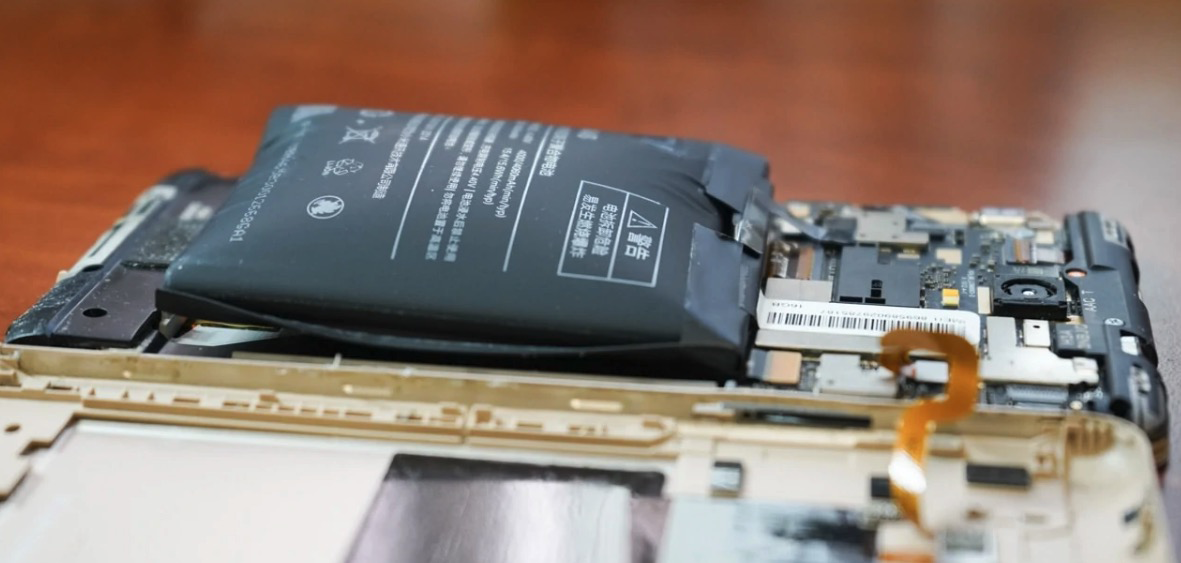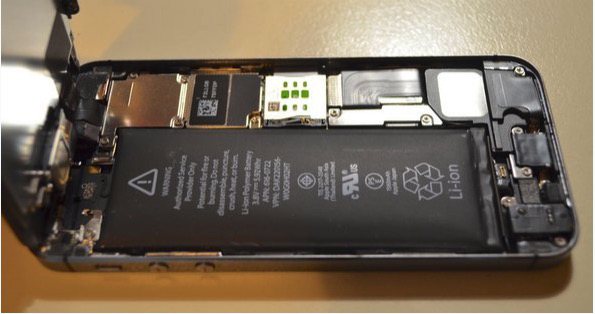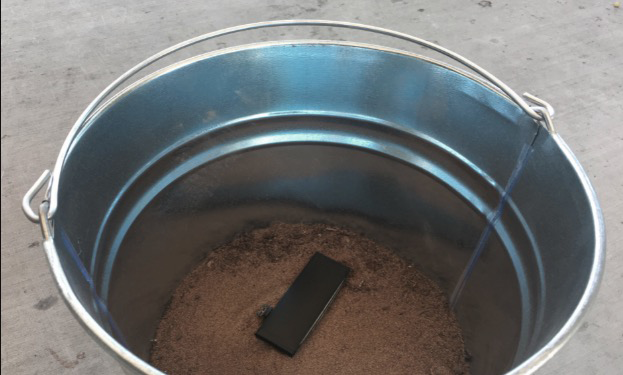
If your device is very hot or has a terrible smell, do not try to remove the battery. If your device emits smoke, clear the area around it.
If you can't move your device, you can smother the fire with sand, a certified fire extinguisher, sprinkle it with a large glass of water, or cover it with a fireproof container and walk away. If you can move the device safely, put it in a fireproof, well-ventilated area like an area with a concrete floor—then stay away until the battery is cold. Once a battery catches fire, the reaction continues until the fuel runs out.
AN INFLATED LITHIUM-ION BATTERY CAN CATCH FIRE OR EXPLODE. PROCEED WITH GREAT CARE AND AT YOUR OWN RISK BY REMOVING AN INFLATED BATTERY FROM AN ELECTRONIC DEVICE. IF YOU HAVE ANY DOUBTS ABOUT YOUR ABILITY TO DO THIS SAFELY, TURN OFF AND ISOLATE THE DEVICE, AND THEN CONSULT A PROFESSIONAL REPAIRER IMMEDIATELY.
Removing an inflated battery can be dangerous, but leaving it inside the device can also carry risks. To avoid possible damage to the device or bodily injury, a device with an inflated battery should not be used. These instructions provide best practices for removing inflated batteries, but cannot guarantee a safe repair. If you have any doubts, turn off the device, put it in a fireproof container, then consult a professional repairman and ask him to remove the defective battery. Do not postpone the removal of a battery. If your inflated battery was purchased from iFixit, take pictures of the battery before and after removing it, then contact our customer service for a warranty claim or exchange.
Lithium-ion batteries use a chemical reaction to produce energy. As the battery ages, these chemical reactions no longer perform perfectly, which can cause gas creation (or degassing) and therefore lead to battery swelling. In addition, if the chemical layers of the battery do not have the appropriate gap (due to damage or defect), degassing, swelling and even fire can occur. The swelling results from the fact that particles become trapped between the layers of the battery and possibly from the perforation of the membranes that separate the layers. If the coating has been damaged, the moisture in the air can react with the cell and cause it to swell. This explosive reaction sadly affected the Samsung Galaxy Note7 and hoverboards and led to severe restrictions on the delivery of batteries and their transport by air.

When the batteries swell, they swell and push the other components. Often the screen, buttons or trackpad are pushed out of their normal location. Your battery may be inflated if the phone shell no longer fits in place as before, if there is a gap between the components, if the buttons become rigid and difficult to operate, or if your device gives more "soft" than usual.

Practice safe sniffing tests! Never stick dangerous substances near your face and do not inhale deeply, instead inspect the area near your battery. You may notice a sweet metallic chemical smell that could be gas escaping from the swollen battery.
If your device opens easily without interfering with the battery, such as on a Macbook or iPhone (check out the battery replacement tutorial to find out!), you can open it and visually inspect the battery swelling. If the battery has a loose or wrinkled coating, if it is more rounded than square or seems to come out of its housing, it is inflated.
If you suspect that your battery has swollen, do not charge your device. Drain the battery as much as possible - this reduces the risk of fire.
Work in a well-ventilated area to diffuse fumes. Wear goggles - ideally full goggles but safety goggles are better than nothing. Wear gloves to prevent your skin from coming into contact with the battery. Have a pair of long blunt tweezers handy so you can safely move a damaged battery.

In case the battery starts to ignite or let substances escape, you need a safe place to store it. Work on a fireproof surface and outdoors if it is cool and dry. Prepare a fireproof container, such as a sealed metal box, a metal bucket filled with sand or equivalent. If water is your only option, use a lot of it. If you work indoors, make sure you have an emergency exit clear to the outside, where the battery reaction can continue safely.
Once the previous precautions have been taken, you can start removing the battery. For the most part, you can follow your device's battery replacement tutorial, but extra precautions should be taken to avoid damaging the battery when removing it. If the battery is glued, we advise you to start with solvent such as iFixit adhesive remover, isopropyl alcohol in high concentrations or acetone. The remover will minimize the need to leverage or bend the battery. Keep in mind that acetone can damage plastic components and all solvents should be used in moderation, as they are flammable. Use only plastic tools and avoid sharp objects that can puncture the battery coating. Perforating the battery can cause a dangerous fire. If at any time the smell becomes stronger, the device heats up or smoke appears, put the device outside or in a fireproof container and wait for the symptoms to dissipate before starting again.
Once you have removed the battery, you should safely discard it. Do not throw batteries in the trash or in recycling bins. Do not put/drop the battery in water. If the battery is hot, smells bad or smokes, put it outside, away from any flammable material or in a fireproof container and wait for the symptoms to dissipate. Once it is no longer in imminent danger, take the battery to a local e-waste collection site; refer to our e-waste wiki to find a site near you. Never send the battery to an e-waste treatment organization by mail. There are strict regulations in this regard, as the battery could cause damage during transport.
Batteries are consumable parts, no matter how you take care of your batteries, they will probably need to be replaced. That said, below are some best practices to keep your battery healthy for as long as possible. But it is important to note that we cannot recover a swollen or defective battery; you can only remove it. These tips can only help to curb battery degradation.
Batteries work best if charged and discharged slowly and under control, used at moderate temperatures, and protected from shock and damage. Even if the battery on a phone or computer usually doesn't charge or discharge fast enough to cause a problem, fast charging and discharging can wear out the battery prematurely and lead to degassing. Avoid using a poor quality or damaged charging cable or adapter, as this may cause uncontrolled, irregular or excessive loads. This can cause damage or even cause a fire. Leaving your battery 100% charged or completely empty for a long time can also shorten your battery life. So if you plan to store your device for several weeks without using it, charge or unload it to about 40% beforehand and turn it off. High temperatures can also reduce battery efficiency, so don't leave your phone in a car when it's hot. And most importantly, dropping your phone damages not only your screen but also your battery. Just like cars, phones are supposed to bend in an accident, so even a glued battery can bump into nearby components in the event of a fall, resulting in a puncture. Replace your battery if it is damaged or no longer holds the charge for a long time.
TL;DR: Be nice to your battery. Use it carefully and replace it if it is damaged or no longer holds the load properly.